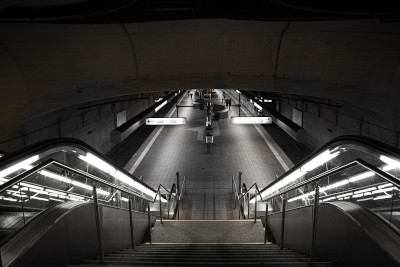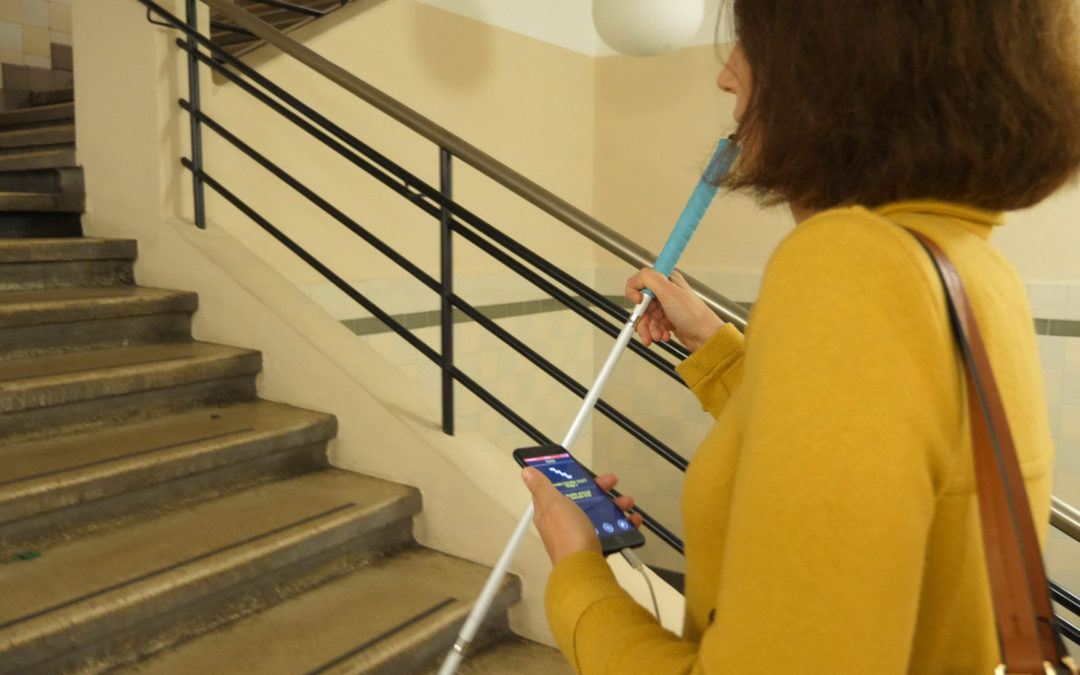
Open Data Is Key to Fostering Universal Accessibility
What’s open data to you? A library gathering random information about your city? A way to promote the city’s services? What if open data was much more powerful than that?
For smart cities, open data may seem like a box to check. Something to implement to be more connected to its residents and to finally be called smart cities.
But it’s not just making information available to all, it’s also about making accessibility more visible and reachable for those who depend on it. Are there accessible pedestrian signals on my way to work? Does the museum I want to visit have elevators or access ramps?
Ultimately, open data can be a powerful tool to enhance universal accessibility and inclusion. It benefits everybody, not just people with disabilities.
Let’s see how open data aligns with smart cities and universal accessibility.
Why is open data an asset for smart cities?
A smart city that didn’t make its data free and available to all wouldn’t be called a smart city.
The name says it all: open data means that it’s openly accessible. It can be shared. It can be stored. It’s here to help people navigate a city and better understand its services.
A smart city combines information and communication technology (ICT) and the Internet of Things (IoT) to optimize its services. The goal of a smart city is to be connected to its citizens.
What better way for a city to be closer to its residents and tourists by giving them the keys to all its operational services?
Knowledge is power as it is said. Nowadays, especially in a smart city, it seems to be embodied by open data.
Here’s how we can sum up its advantages:
⊗ Collecting data on the city’s services and how they are used. For example, how many times the accessible pedestrian signal is activated?
⊗ More connection with residents: they have the keys of the city. They know how to make the best of it to suit their needs.
⊗ Solving problems met by residents and answering them: with how residents use open data, the city can anticipate the problems they may face.
⊗ Better use of services: easily access public transportation with-real-time information on traffic…
Plus it helps that with open data, users always have updated information.
What does open data do for cities regarding accessibility?
The challenge is huge: collecting, using and analyzing data to make accessibility equipment and solutions more accessible and visible for residents.
Open data offers people with disabilities a new way of apprehending their city, a new way of navigating. It guarantees a seamless mobility chain.
How can people with disabilities use open data in a smart city?
Thanks to open data, people with disabilities can plan their routes accordingly. This means a blind user can select a route depending on accessible pedestrian signals. Just like a wheelchair user can focus on lowered curbs, access ramps and wide pathways to get around.
Let’s take a look at open data solutions that improve the lives of people with disabilities.
OpenStreetMap: the free and editable map of the world
OpenStreetMap is directly managed by its community. Mappers collect accessibility data in the entire world.
The goal is to provide people with disabilities with the best and most accurate accessibility information.
Thanks to volunteers, users can know where to find tactile paving, audio signage, handicap parking spots, tactile maps, accessible restrooms, handrails, guide paths, audio induction loops…
They can find any type of equipment to make sure they have a smooth trip when leaving the house.
OpenStreetMap collects data on public roadways, venues and public transportation to cover all mobility areas.
Route planners: pedestrians have the tools to find the best trip for them
Route planners like Google Maps are an everyday life tool for many of us.
But there’s one that has caught the eye of smart cities: MaaS (Mobility as a Service).
This trip planner gathers all modes of transportation. Whatever their capabilities are, people with disabilities can find all the information they need on public transit networks.
For now, Pittsburgh, Pennsylvania is the only American city to provide MaaS for its residents. But it’s largely deployed in Europe: Helsinki, Madrid, Antwerp, Budapest…
OpenSidewalks and AccessMap: sharing data on the built environment and roadways in the U.S.
Here we have two projects managed by Dr. Anna Caspi, director of the Taskar Center for Accessible Technology at the University of Washington, and Nick Bolten, a Postdoctoral fellow in the Paul G. Allen School of Computer Science & Engineering.
With OpenSidewalks, the goal is to focus on pedestrians with limited mobility to connect them with accessible pathways and multimodal transport networks.
Dr. Anna Caspi and Nick Bolten used data collected from OpenSidewalks to create AccessMap, a web application that maps the streets of Seattle, Bellingham and Mount Vernon in Washington.
But this app even goes further by catering to needs of a large variety of profiles. After all, a person using an electric wheelchair may not have the same abilities and needs as a person using a manual wheelchair.
Taking into account the different capabilities of pedestrians is key to make sure AccessMap can enhance their mobility.
Locations of accessible pedestrian signals
In Canada, cities like Toronto use open data to list all traffic signals in the city, including accessible pedestrian signals.
This is particularly convenient for blind and visually impaired people since they can plan their itineraries accordingly. Thanks to open data, they know exactly where APS are located.
They know they can depend on accessible pedestrian signals to cross the street with complete autonomy.
Find out more about communicating about APS with our article:
These examples only show one thing: that in a world that never stops changing, open data is set to be deployed across the world to make sure people with disabilities aren’t left behind.
Of course, raw data can easily overwhelm anybody. It first needs to be “translated” in a language understandable by all. And for people with disabilities, it needs to be accessible whether it’s on a website or an app.
Open data is a wake-up call for universal accessibility
Open data makes accessibility issues more visible. Indeed, cities are faced with everything that’s not adapted for people with disabilities: a lack of APS, an elevated curb, no elevators at a subway network…
But it’s not necessarily a bad thing. Because it emphasizes accessibility, it’s actually an opportunity to set things right and to reach universal accessibility. Another key concept for smart cities.
What’s the difference between accessibility and universal accessibility?
First, we need to define what accessibility and universal accessibility are.
Accessibility focuses on adapting solutions for people with disabilities to share the same experience as any other person.
As an example, screen readers for blind people aim at ensuring they can easily use their smartphones.
Universal accessibility, also known as universal design or design for all, focuses on providing one solution tailored to meet the needs of everybody.
For universal design to be successful, cities first have to take into account all mobility types, intellectual and physical capabilities… from the very beginning of a project.
It’s the very core of inclusion. And it truly benefits everybody:
⊗ People with disabilities: this term comprehends those with visual, hearing, mental, intellectual or physical disabilities. Disabilities can only be plural as there are many different abilities to consider. Two people with visual impairments may not have the same needs.
⊗ People on the autism spectrum.
⊗ ADHD people.
⊗ People with a specific learning disorder like dyslexia.
⊗ Elderly people: when we’re young, we may not need to know where the elevators are located but we’re all getting older. At some point in our life, we may have reduced mobility. Plus the world has a growing aging population in need of universal accessibility.
⊗ Illiterate people: easily understandable pictograms are essential for them.
⊗ Foreigners who don’t speak the language of the country they’re visiting…
Open data means more inclusion for all
Ultimately, that’s the power and responsibility of open data. It enhances universal accessibility, equity and inclusion:
1. Open data gives access to information.
2. It removes barriers and obstacles for users.
3. It stresses the missing links of the mobility chain.
4. It concerns every smart city but more globally, the entire world.
5. It advocates for universal accessibility for a higher quality of life.
Open data represents the first step towards universal accessibility. It shows cities how they need to improve to be more inclusive. Because everybody deserves to be comfortable getting around in their city.
Want to know more about accessibility data and smart cities? Check out these articles:
Accessibility Data Collection: a Huge Challenge for Cities and Transit Networks
How Can a Smart City Make Life Easier for People with Disabilities?
Published on April 21st, 2023
media

Open data makes accessibility issues more visible. Indeed, cities are faced with everything that’s not adapted for people with disabilities (…) But it’s not necessarily a bad thing. Because it emphasizes accessibility, it’s actually an opportunity to set things right and to reach universal accessibility.
writer

Carole Martinez
Content Manager & Copywriter
stay updated
Get the latest news about accessibility and the Smart City.
other articles for you
Our Audio Beacons Guide the Blind and Visually Impaired at the Helsinki Subway
The Helsinky subway improved their audio signage system by installing on demand and remotely activated audio beacons.
7 Good Reasons to Install Audio Beacons at Your Public Transport Network
Audio beacons are an efficient way to provide more autonomy to blind and visually impaired people. They can easily use public transport.

Will Remote Activation Become the Norm for Accessible Pedestrian Signals?
More and more cities like New York have been exploring remote activation to trigger accessible pedestrian signals.

How Does a Blind Person Use Their Smartphone to Improve Their Mobility?
The smartphone has revolutionized the mobility of blind and visually impaired people.
share our article!
more articles

Disability Statistics in the US: Looking Beyond Figures for an Accessible and Inclusive Society
Disability Statistics in the US: Looking Beyond Figures for an Accessible and Inclusive Society Around 61 million adults in the United States live with a disability. Diving into disability statistics in the US will help us know exactly who is concerned and what...
Our Audio Beacons Guide the Blind and Visually Impaired at the Helsinki Subway
Our Audio Beacons Guide the Blind and Visually Impaired at the Helsinki SubwayOur audio beacons equip the new line of the Helsinki subway in Finland. They help blind and visually impaired people locate the points of interest of a station. For users with visual...

Will Remote Activation Become the Norm for Accessible Pedestrian Signals?
Will Remote Activation Become the Norm for Accessible Pedestrian Signals?Without pushbutton, there are no accessible pedestrian signals. That’s how APS work in the U.S. But more and more cities have been exploring remote activation like New York City. The Department...

Hearing Impaired People: a Multitude of Profiles for Different Needs
Hearing Impaired People: a Multitude of Profiles for Different Needs Did you know that hearing impaired people have several profiles and that the way they identify themselves is important? You may be familiar with deaf and hard of hearing people but for each of...
NEVER miss the latest news about the Smart City.
Sign up now for our newsletter.
Unsubscribe in one click. The information collected is confidential and kept safe.
powered by okeenea
The French leading company
on the accessibility market.
For more than 25 years, we have been developing architectural access solutions for buildings and streets. Everyday, we rethink today’s cities to transform them in smart cities accessible to everyone.
By creating solutions ever more tailored to the needs of people with disabilities, we push the limits, constantly improve the urban life and make the cities more enjoyable for the growing majority.


